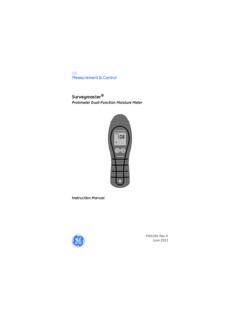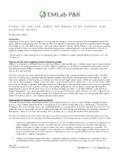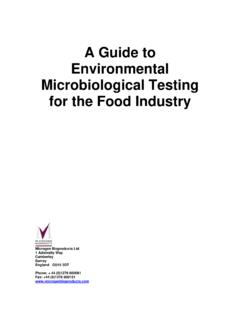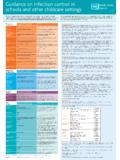Transcription of USP General Chapters <797> & <800> Environmental …
1 Download the PDF: USP General Chapters <797> & <800> Environmental monitoring Participants will be in listen only mode. 9 (PST) Presented by: Michael Berg, Continuing Education Units (CEUs) To receive a certificate of attendance, you must complete the survey after the webinar: Click on the survey link in the Thank you email. (sent 1 hour after this webinar) Complete survey within 24 hours. You will receive an email in 2-3 weeks when your certificate is ready. Outline Introduction to General chapter USP <797> Personnel training Environmental monitoring and sampling Investigation of excursions and remediation USP <800> Handling of hazardous drugs in healthcare facilities Revision of Chapters <795>.
2 <797> & <800> 4 <795> Pharmaceutical Compounding Nonsterile Preparations <797> Pharmaceutical Compounding Sterile Preparations <800> Hazardous Drugs Handling in Healthcare Settings Update on Appeals Panel Decision General Chapters <795> and <797> The Appeals Panel has granted the appeals to General Chapters <795> and <797> and is remanding the Chapters to the Compounding Expert Committee (CMP EC) with the recommendation for further engagement on the issues raised concerning the beyond-use date provisions. Implications: The currently official Chapters of <795> (last revised in 2014) and <797> (last revised in 2008) remain official.
3 General Chapters <800> The new General Chapter <800> was made official on December 1st, 2019. What is USP <797>? USP-NF establishes standards for medicines, food ingredients and dietary supplements. General Chapter USP <797> establishes best practices and regulations for the production of compounded sterile preparations. 5 Monographs General Chapters General Notices General Chapters establish procedures, methods and practices. Monographs includes the name of the ingredient or preparation; the definition; packaging, storage, and labeling requirements; and the specification.
4 General Notices help with the interpretation of USP NF standards Abbreviations and Terms Abbreviations: USP-NF: United States Pharmacopeia National Formulary CSP: Compounded Sterile Preparation PEC: Primary Engineering Controls BUD: Beyond Use Dating DCA: Direct Compounding Area CAI: Compounding Aseptic Isolator BSC: Biological Safety Cabinet 6 Terms: clean room Buffer Area Ante Area Aseptic Processing Preparation Product USP General Chapters General Chapters in the USP-NF Numbered below <1000> Compendium and discretionary State requirements Made applicable through General notices, monographs or another applicable General Chapters below <1000> Numbered <1000> to <1999> Informal Chapters Numbered <2000> and above Dietary supplements 7 Sterile Compounding Sterile compounding.
5 Combining, diluting, pooling, reconstituting or otherwise altering a drug or bulk drug substance to create a sterile preparation. This includes: Altering the dosage form or delivery system of a drug Altering the strength of a drug Combining components or active ingredients Preparing a drug product from chemicals or bulk drug substances 8 USP <797> applies to all persons who prepare and all places where compounded sterile preparations (CSPs) are made for humans or animals. Compounded Sterile Preparations Examples of CSPs: Injections Total Parenteral Nutrition (TPN) Preparations for pulmonary inhalations Baths and soaks for live organs and tissues Irrigations for internal body cavities Implants 9 Scope of USP <797> Practices out of Scope for USP <797> Sterile radiopharmaceutical compounds USP <825> Preparations per approved product labelling Single dose, single patient Labeling must include diluent, strength, storage time.
6 Container closure system Immediate use CSPs Single patient prepared from not more than three different sterile products Unused medication from a single dose vial must be discarded Administration must begin within four hours Must be appropriately labelled if not administered by preparer 10 Cleanroom Design 11 Ante room Buffer room PEC (ISO 5) ISO 8 ISO 7 Cleanroom: Hazardous Compounding 12 Ante room Buffer room PEC (ISO 5) ISO 7 ISO 7 Mission of Chapter <797> Goal of USP <797>: Minimize harm, including death to humans and animals that could result from Microbial contamination (non-sterility) Excessive bacterial endotoxins Variability from the intended strength of active ingredients Physical and chemical incompatibilities Chemical and physical contaminants Use of ingredients of inappropriate quality 13 Revision Risk Categories Risk categories (low risk, medium risk and high risk compounding) have been collapsed in the new revision.
7 However, the 2008 version remains official at this time Immediate and emergency use CSPs are not subject to same requirements 14 Low Risk No more then 3 sterile products CSPs administered within 48 hrs (RT), 14 days (refrigerated), 45 days (frozen) Medium Risk Complex manipulations CSPs administered to more then one patient or same patient multiple occasions BUD: 30 hrs (RT), 9 days (ref.), 45 days (frozen) High Risk Produced with non-sterile components or process exposed to worse than ISO5 for >1 hr Requires terminal sterilization BUD: 24 hrs (RT), 3 days (ref.)
8 , 30 days (frozen) Any person handling CSPs and/or accessing the compounding area must be trained A designated person is responsible for overseeing the training program Visual observation, training and testing of compounding personnel may be performed by A designated person or an assigned trainer Written training program including: Specifics of required competencies Frequency of training Process for evaluating competencies Visual observation, written or electronic test Documentation of training results Personnel Training 15 Personnel Training (cont d) Personnel must demonstrate and be tested for core competencies initially and every 12 months in.
9 16 Hand hygiene Garbing Cleaning and disinfection Calculations, measuring and mixing Aseptic technique Achieving and/or maintaining sterility and apyrogenicity Use of equipment Documentation of compounding process Principles of HEPA-filtered unidirectional airflow within the ISO 5 area Proper use of primary engineering controls (PECs) Principles of movement of materials and personnel within the compounding area Personnel Training Microbial Testing Gloved fingertip testing Press all fingers of one hand including thumb on a media plate ( TSA w/ polysorbate 80 & lecithin) after performing hand hygiene and garbing procedure.
10 Initial qualification three times with no growth on either plate (left and right hand). Continued qualification testing every 6 months with a maximum of 3 cfu for both hands combined. 17 Isolator box: test sterile gloves placed over the equipment gloves. Personnel Training Microbial Testing (cont d) Media fill testing Simulation used to qualify processes and personnel engaged in sterile compounding to ensure that the processes and personnel are able to prepare CSPs without contamination. Initial qualification and every 6 months thereafter. 18 Replace ingredients with soybean-casein digest medium (TSB) and perform most challenging procedures that the trainee may encounter.







